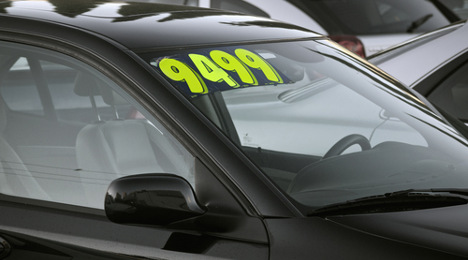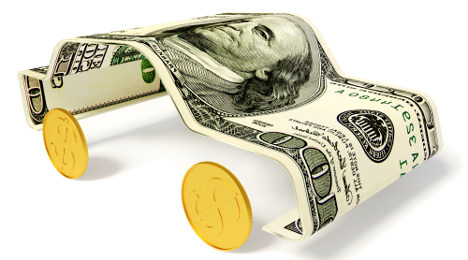Make it two consecutive months where the Manheim Used Vehicle Value Index established a new record.
Analysts determined wholesale used vehicle prices (on a mix-, mileage- and seasonally adjusted basis) increased 1.1 percent month-over-month in June. This movement brought the index reading to 129.3, which was a record high for the second consecutive month and represented a 2.5 percent increase from a year ago.
“Like May, the June index result challenges concerns that increasing wholesale supplies from near-peak-off-lease volumes and rising rental volumes would lead to rapidly declining used car values,” Cox Automotive chief economist Jonathan Smoke said in commentary associated with the latest index update.
“Instead, strong retail demand for recent model year used vehicles is encouraging dealers to buy more vehicles from auction heading into the summer. The increased demand is more than offsetting the higher supply,” Smoke continued.
“The volume of transactions is up more dramatically than supply thanks to real demand from dealers and, in turn, consumers,” Smoke went on to say. “Broadly speaking, the second quarter was supported by continued low unemployment and strong consumer confidence remaining near a 16-year high.”
Fueling the year-over-year rise were prices for pickups and vans, which rose by 7.5 percent and 7.4 percent, respectively. Manheim’s index report also pointed out price rises for SUVs and CUVs (up 2.0 percent) as well as luxury cars (up 1.4 percent).
Falling year-over-year were both compact cars (down 0.4 percent) and midsize cars (down 2.1 percent).
Sliding over the rental market, Manheim noted that rental risk pricing eases, thanks in part to higher volume.
Analysts found that the average price for rental risk units sold at auction in June softened by 4 percent year-over-year, but rental risk prices ticked up 0.2 percent compared to May.
Manheim also mentioned SUVs and CUVs accounted for 32 percent of rental risk sales in June of this year versus 30 percent last June. The share of compact cars fell from 25 percent to 23 percent.
Analysts added that average mileage for rental risk units in June came in at 40,600 miles, an amount 2 percent below a year ago.
Editor’s note: More commentary and analysis from Smoke’s first quarterly conference call will appear in future reports from Auto Remarketing.
Well, the convergence of cars and trucks depreciating at the same rate lasted all of a week.
The newest Black Book Market Insights report showed truck segments deprecating only by 0.9 percent last week, much less that in comparison with the car segments, which depreciated by 0.31 percent overall.
In fact, editors noticed three specific truck segments increased their value, including the full-size van, small pickup and full-size pickup.
Black Book also mentioned the recent truck performance produced a better than the average decrease since the firm spotted depreciation of 0.17 percent per week during the previous four weeks.
While those three truck segments saw an uptick, sub-compact luxury crossover/SUV and compact luxury crossover/SUV values dropped the most by 0.37 percent and 0.27 percent, respectively.
Over on the car side, looking at volume-weighted data, editors reiterated that overall car segment values declined by 0.31 percent last week. In comparison, the market values had decreased on average by 0.35 percent per week in the previous four weeks.
Within car segments, Black Book noted sub-compact car and compact car segments performed the worst, decreasing by 0.52 percent and 0.85 percent, respectively.
“Higher depreciation continued in sub-compact car and compact car segments driven by recent drop in gasoline prices. The average U.S. gas price per gallon has dropped by over 10 cents in the last three weeks,” said Anil Goyal, Black Book’s senior vice president of automotive valuation and analytics.
When Black Book’s representatives in the lanes reported back to headquarters, the dealer chatter continued to focus on trucks. And it came from both ends of the country.
First in North Carolina, “Had a lot of comments about high prices from dealers trying to buy nice, low mileage trucks.”
Then in Washington, “Pickup trucks are still king here. Mid-size and compact sedans struggled more than the past few weeks.”
The other anecdotes gave an indication of where dealers stand as the Fourth of July passed.
From Texas: “Dealers say they are building inventory around the July 4th holiday.”
In Colorado: “The dealers say they need inventory and are searching all of the resources to find their type of vehicles.”
And finally in Pennsylvania: “Most of the sales resulted from online buyers, as there weren’t many people in the lanes.”
Along with taking a closer look at how volume will impact compact cars’ residual values, RVI Group’s Risk Outlook for June indicated that used-vehicle prices in May softened on a year-over-year comparison but ticked slightly higher on a sequential basis.
The report indicated that real used-vehicle prices for 2- to 5-year-old units on a seasonally adjusted base fell by 4.7 percent year-over-year in May, after adjusting for MSRP. Looking month-over-month, RVI Group determined real used-vehicle prices increased by 1.3 percent.
In the compact cars segment, analysts determined prices fell by 6.9 percent in May on a year-over-year basis.
“The increasing supply of used vehicles and steady growth of incentive activity will continue to put downward pressure on used-car prices,” analysts said in the report. “Lease penetration is expected to remain near historical highs through 2020.
“As the increased supply of off-leased vehicles re-enter the market, we expect to see further declines in used-car prices,” analysts continued, while projecting that real used-vehicle prices are expected to decline 12.7 percent from current levels by 2020.
Residual outlook
RVI Group mentioned the lease penetration rate for first quarter came in at 22.7 percent of total new-vehicle sales.
In May, the firm’s lease supply index rose 22.3 percent when compared to May of last year.
“Given the high leasing rates over the past two years, we expect off-lease supply to continue growing through 2021,” analysts said in the report.
RVI Group continued its residual value discussion by taking a deeper look at compact cars. The firm reiterated that prices for these units softened by 6.9 percent year-over-year in May.
“The supply of used compact cars has grown over the past two years. Looking forward, we expect the supply of used vehicles in this segment to continue to grow through 2020,” analysts added.
More notes on new cars
RVI Group pointed out that light new-vehicle sales declined slightly to 16.7 million SAAR in May. On a year-over-year basis, light vehicle sales declined by 2.4 percent in May.
While the lease penetration rate for the first quarter remained steady on a sequential basis at 22.7 percent of total sales, analysts pointed out that market level incentive activity has continued to grow, increasing to 9.8 percent of MSRP in May from 9.6 percent of MSRP in April.
Also in May, the report noted the new vehicle CPI increased by 0.4 percent on a year-over-year basis but decreased by 0.2 percent on a month-over-month basis.
Economic thoughts
Looking more broadly, RVI Group declared in the report that key economic indicators signal that the U.S. economy is “softening.”
In the first quarter, analysts recapped that GDP grew at an annual rate of 1.2 percent, down from 2.1 percent in the fourth quarter of 2016.
“The slowdown was caused by a decrease in federal government spending, private inventory investment, and state and local government spending that offset positive contributions coming from personal consumption expenditure, exports and residential and nonresidential fixed investment,” RVI Group said in the report.
In May, the report mentioned the U.S. unemployment rate came in at 4.3 percent, a slight decline from 4.4 percent from the previous month, while the labor participation rate showed little change from April to May. Inflation came in at 1.9 percent for May.
Overall used-vehicle values are high, hoisted by truck prices strong enough to pull weakened used cars along for the ride.
It’s a trend most analysts who measure how the growing onslaught of off-lease cars and trucks impact used-vehicle prices expect to continue, at least for the rest of 2017.
But they also expect laws of supply and demand and rising new-vehicle inventories and incentives to continue to put downward pressure on used-vehicle prices.
“Cumulatively, it gets tougher and tougher” for the market to efficiently absorb those vehicles, said Tom Kontos, chief economist at KAR Auction Services. “Even though the market has been remarkably resilient to this point, it becomes even more difficult as we go into the second half of the year.”
Jonathan Smoke, chief economist at Cox Automotive, said consumers’ vehicles depreciate at a rate of about 1.7 percent per month, having grown from about 1.5 percent per month over “the last couple of years.”
The faster depreciation pace reflects the growing volume of used-vehicles in the marketplace, he said.
“That’s going to continue because we don’t reach the peak level of off-lease vehicles until around 2019,” Smoke added.
Still, the Manheim Used Vehicle Value Index has not reflected price declines industry watchers expected to see this year, Smoke said.
In fact, after four months of being relatively flat, the index hit a record 127.9 in May, buoyed by strong consumer demand for used-vehicles and a rising number of higher priced late-model, off-lease vehicles at auctions.
May’s reading is up from 124.7 in April and 124.4 in May 2016. The index’s previous record of 127.8 was in May 2011. The index reflects wholesale used-vehicle prices and is adjusted for vehicle mix, mileage and time of year. It cannot be adjusted to reflect vehicle age, said Smoke, noting that May’s auction inventory “was the youngest mix of vehicles we’ve ever seen.”
Index remains stable
He expects the index for the rest of the year to roughly remain stable with no substantial movement in either direction.
Smoke said Cox Automotive is updating its off-lease vehicle projections to more accurately reflect the many off-lease vehicles that enter the used-vehicle market ahead of their original lease end-date under manufacturer pull-ahead programs.
He said it is more accurate to refer to annual off-lease numbers as “lease maturities.”
In 2017, lease maturities are projected to total 3.6 million units and peak between 4.1 million and 4.3 million in 2019, Smoke said. That’s up from 3 million in 2016.
Data compiled by KAR Auction Services shows that the average price of used vehicles overall grew 3.9 percent in May — the most recent information available at press time — compared to May 2016.
Leading the way were trucks, with an average price in May that grew 4.5 percent year-over-year to $13,244. But the average price of used cars in May stayed nearly identical at $8,954.
The year-over-year declines are even deeper for some three-year-old vehicles with 36,000 to 45,000 miles on their odometers. For example, the average price of midsize cars within those perimeters plunged 6 percent to $11,715; average prices of compact SUVs and CUVs combined skidded 3.6 percent to $20,192.
KAR Auction’s Kontos said these vehicles, sold by financial institutions, fleet/leasing companies and others, are good proxies for off-lease vehicles that typically enter the marketplace after about 36 months.
“When you look at averages and indexes you can be deceived into thinking things are better than they are,” he cautions.
Ivan Drury, senior analyst at Edmunds, agrees that prices of 3-year-old used vehicles, though still fairly high, are trending lower and will continue to do so the rest of the year.
But it’s going to “be a while” before the price decrease trickles down to 6- and 7-year-old vehicles, he said. Supplies of those vehicles are tight because new-vehicle sales and leasing plunged during the 2008-2010 economic downturn.
Recession remnants
For example, in the first quarter of 2017, the average price of a 6-year-old vehicle was $15,100, representing 47 percent of its $32,000 MSRP. That is up from an average price of $11,100 in the first quarter of 2010, or 38 percent of its $29,500 MSRP.
Drury said “basic transportation” vehicles in the $5,000 to $10,000 range are generally 9 to 12 years old and in such high demand, dealers can’t keep them on their lots.
“You need to get somewhere, you need it for a job; whatever the need may be, that’s the kind of car people are hoping to get and unfortunately, it’s slim pickings,” he said.
J.D. Power Valuation Services, formerly NADA Used Car Guide, expects used-vehicle prices to tumble 6 percent in 2017, compared to a 4 percent slide in 2016.
David Paris, J.D. Power analyst, said used-vehicle prices are being pressured by plateauing new-vehicle sales and increasingly higher incentives to move them. Though some manufacturers have announced production cuts, Paris said it may not be enough to bring new-vehicle inventories in line with slowing sales. When new-vehicle transaction prices decline, used-vehicle values follow suit.
“We’re really seeing a lot of pressure from the new side of the market,” he added. “They’re still building cars and growing incentives to sell them.”
With some upbeat signs in the lanes that dealers are preparing to move used metal as the summer heats up, the Black Book Market Insights report showed car and truck segments depreciating at the same level.
Editors determined that both overall segments softened by 0.25 percent last week. They also mentioned compact vans performed the best, increasing their value by 0.07 percent, while sporty cars saw no price declines during the week.
“Overall, the wholesale markets performed well last week. Weaker spots were seen in the sub-compact crossover and compact crossover/SUV segments,” said Anil Goyal, Black Book’s senior vice president of automotive valuation and analytics.
As mentioned, volume-weighted data showed overall car segment values decreased by 0.25 percent last week, lower than the average weekly decrease of 0.39 percent in values over the previous four weeks.
Black Book pointed out that prestige luxury car, midsize car and full-size car segments declined the most by 0.52 percent, 0.45 percent and 0.42 percent, respectively.
On the truck side, again, the volume-weighted information showed the overall segment values (including pickups, SUVs and vans) dipped by 0.25 percent last week, higher than the average weekly decrease of 0.18 percent in values over the previous four weeks.
As Goyal alluded to, sub-compact crossover, sub-compact luxury crossover and compact crossover/SUV decreased the most by 0.51 percent, 0.47 percent and 0.44 percent, respectively.
Turning next to Black Book’s representatives in the lanes, one of the most interesting anecdotes came from Pennsylvania.
“Was an OK sale here today. It was worth noting that most of the buyers were online and not in attendance,” Black Book’s auction watcher in the Keystone State said.
Sticking in the Northeast, the lane watcher in Massachusetts recapped, “Today’s auction was better than last week and prices were stable.”
Sliding over to the Midwest, the report out of Wisconsin noted, “Dealers were cherry picking today.” But in Indiana, the action was a little bit livelier.
“A good sale today but consignment was down again, which helped keep the values up. Dealers here are buying in order to have inventory for what is expected to be a decent summer market,” the Black Book representative stationed in the Hoosier State said.
Down in Texas, the scene was, “Prices are holding steady here as bidding was good, as was the number of consigned vehicles.”
Wrapping up the auction action roundup, Black Book’s observer in Florida added, “The commercial lanes did better today. The dealer lanes struggled with lots of no-sales.”
With dealer consignment activity softening for a variety of reasons, the newest Black Book Market Insights report showed that small cars continue to feel heavy depreciation.
And editors added that small crossovers are also sustaining larger valuation drops, as well.
Out of all vehicle categories within the car segment, the report indicated sub-compact cars declined the most, dropping by 0.68 percent.
“The smallest vehicles, including sub-compact car, sub-compact crossover and sub-compact luxury crossover, have experienced heavier depreciation levels as gas prices remain low,” said Anil Goyal, Black Book’s senior vice president of automotive valuation and analytics.
Reviewing volume-weighted data, Black Book found that overall car segment values decreased by 0.35 percent last week, slightly lower than the average weekly decrease of 0.39 percent in values over the previous four weeks.
As Goyal referenced, sub-compact car, mid-size car, prestige luxury car and compact car segments declined the most by 0.68 percent, 0.53 percent, 0.50 percent and 0.48 percent, respectively.
Looking again at volume-weighted information, Black Book determined overall truck segment values — including pickup, SUVs and vans — dipped by 0.23 percent last week, similar to the average weekly decrease of 0.24 percent in values recorded during the previous four weeks.
Editors mentioned sub-compact luxury crossover and compact van were the worst performing truck segments, while pickup trucks values remained flat last week.
Turning next to what Black Book gathered from its representatives in the lanes, it seemed the talk at auctions revolved around dealer consignment.
The dialogue began out West with a lane watcher in Washington noting, “A new-car dealer says that they are keeping most of their trade-in inventory if the vehicles meet some minimal requirements.”
Sliding into the Midwest, a similar story appeared in Indiana as Black Book’s representative reported, “Consignment is still down here. with more buyers than sellers at the auction. The really nice, clean vehicles remain scarce.”
And the topic of dealer consignment percolated in Georgia, too, with the auction observer noting, “The trend of softer values is continuing here. No-sales were higher in the dealer-consigned lanes and the vehicles that did sell had low prices.”
The three other reports Black Book received from its staff in the field touched on a wide array of themes, and they came from various parts of the country, too.
From California: “The market appears to be cooling down. No-sales were more prominent today.”
From Pennsylvania: “A dealer said he is buying in the $8,000 to $15,000 price range with no real concern about the year model of the vehicles. Decent trucks are going to be much older at that price point.”
And out of Texas: “A wholesaler said that he is struggling to find 3- to 5-year-old units with low mileage.”
Analysts at J.D. Power Valuation Services found that May wholesale prices for used vehicles up to 8 years old declined by an average of 1.9 percent.
And their expectations predict a similar softening to happen in June, as well.
According to the June edition of Used Car and Light Truck Guidelines Industry Update, J.D. Power Valuation Services explained that the May price decline ended up being slightly better than the way the month has historically performed during the past 20 years.
“In spite of this glimmer of positivity, the 31-day period underperformed J.D. Power Valuation Services’ expectations for the month,” analysts said in the report. “It appears there has been no payback for February’s abnormally weak performance.”
Should analysts’ June forecast hold true, the report indicated that only a 1.9 percent price softening would be an improvement compared to June of last year.
“At the segment level, mainstream losses are expected to be fairly consistent with the exception of midsize and large pickups, which continue to perform very strongly and are forecast to perform significantly better than the industry average,” the report said.
“Losses for all premium segment are forecast to fall around the industry average,” the report continued.
In terms of full-year expectations, J.D. Power Valuation Services — formerly NADA Used Car Guide — maintained that used-vehicle prices should fall by about 6 percent, which would be 2 percentage points more than the 4 percent drop recorded a year ago.
“Ongoing increase in supply, higher incentives and normalizing retail environment — including credit conditions — will ultimately dictate losses,” analysts said.
More details about May movements
In lieu of a mitigated February federal tax season bounce back, J.D. Power Valuation Services’ seasonally adjusted used vehicle price index managed to increase for the first time in a year, ticking up by 0.8 percent to 111.1.
The May index reading settled 7.6 percent below the year-ago measurement of 120.2.
At the segment level, analysts explained in the report that mainstream segment losses were led by what they deemed to be a “usual suspect,” midsize cars. Prices for these units decreased by 2.6 percent.
The report indicated prices were “weak” for all midsize models, but especially the Nissan Altima, which sustained a 4-percent price decline.
“Additionally, late model year Altima volume accounted for 20 percent of all midsize car volume over the past few months, which has helped keep prices for the group depressed,” analysts said.
Like their sedan counterparts, the report mentioned that midsize van values also softened as prices fell by 2 percent. Analysts attributed that movement to a 70-percent increase in 2017 model year volume, which was traced back to an “elevated” number of Kia Sedona units returning to the marketplace.
Meanwhile on the opposite end of the spectrum, the report pointed out that midsize pickups continue to perform “exceptionally well” despite a 37-percent year-to-date increase in late-model volume.
On the luxury side of the market, J.D. Power Valuation Services mentioned that luxury midsize car prices dropped by 2.6 percent in May, following what the firm called a “strong April showing.”
Prices for luxury large utilities fell by 2.1 percent, which turned out to be the worst May for that segment since 2012, according to the report that also mentioned the decrease came in part because of a “sharp” 8 percent increase in month-over-month auction volume.
When asked about May's 1.9 percent price drop, David Paris, executive analyst at J.D. Power Valuation Services said in separate news release, “It’s normal to see a drop the fifth month of the year. However, this May was a little different since the decline slightly outperformed what we've seen during the month the past 20 years.”
Paris went on to say, “While the index may have increased by 0.8 percent during May, it was 7.6 percent below May of last year. That said, we expect wholesale prices of 8-year-old or younger vehicles to drop about 1.9 percent during June. We still expect prices to decline by about 6 percent for the year as a whole.”
KAR Auction Services chief economist Tom Kontos reported overall wholesale prices in May rose nearly 4 percent year-over-year. But a recent addition to Kontos’ analysis in order to give the industry a better understanding “once again shows significant price softening.”
According to ADESA Analytical Services’ monthly analysis of wholesale used vehicle prices by vehicle model class, wholesale used vehicle prices in May averaged $11,138. The May figure ended up flat compared to April but 3.9 percent relative to May of last year.
Kontos explained that the year-over-year rise came mostly from larger vehicles, including full-size cars, midsize and full-size SUVs/CUVs and full-size pickups. He also pointed out that the year-over-year growth in minivan prices is exaggerated by newer models as discussed in January’s Kontos Kommentary.
“Average wholesale prices in May were flat versus April but up on a year-over-year basis, primarily due to the strength of truck prices and a younger mix resulting from off-lease supply growth,” Kontos said.
“As introduced last month, a drill-down into the data clearly reveals price softening when accounting for sale type and vehicle age, model class and mileage,” he continued.
Kontos again took a look at fleet/lease sales of 3-year-old vehicles with 36,000 to 45,000 miles. He found that May prices for midsize SUVs and CUVs softened by $225 or 1.1 percent year-over-year to settle at $20,225.
The drop-off for midsize cars in this analysis was even steeper as May prices softened by $685 or 5.6 percent to fall below $12,000, landing at $11,595.
“We will continue to monitor and report this information as a supplement to the averages traditionally provided here,” Kontos said while also elaborating in an online video available here as well as at the top of this page.
Elsewhere, Kontos mentioned that average wholesale prices for used vehicles remarketed by manufacturers in May rose 3.3 percent month-over-month and up 4.9 percent year-over-year. Overall May prices for fleet/lease consignors ticked down 0.2 percent sequentially but rose 3.5 percent annually.
Kontos added that average prices for dealer consignors were up 0.2 percent versus April and up 5.9 percent relative to May of last year.
Kontos closed by mentioning data from the National Automobile Dealers Association that indicated May retail used vehicle sales by franchised and independent dealers were down a combined 2.8 percent year-over-year. As also reported by Auto Remarketing, May certified pre-owned sales climbed 7.0 percent year-over-year, according to figures from Autodata.
ADESA Wholesale Used-Vehicle Price Trends
| |
Average |
Price |
($/Unit) |
Latest |
Month Versus |
| |
May 2017 |
April 2017 |
May 2016 |
Prior Month |
Prior Year |
| |
|
|
|
|
|
| Total All Vehicles |
$11,138 |
$11,141 |
$10,718 |
0.0% |
3.9% |
| |
|
|
|
|
|
| Total Cars |
$8,954 |
$8,968 |
$8,952 |
–0.2% |
0.0% |
| Compact Car |
$6,832 |
$6,805 |
$6,835 |
0.4% |
0.0% |
| Midsize Car |
$7,970 |
$7,962 |
$8,045 |
0.1% |
-0.9% |
| Full-size Car |
$8,395 |
$8,504 |
$7,864 |
-1.3% |
6.8% |
| Luxury Car |
$13,765 |
$13,317 |
$13,740 |
3.4% |
0.2% |
| Sporty Car |
$14,313 |
$14,694 |
$14,207 |
-2.6% |
0.7% |
| |
|
|
|
|
|
| Total Trucks |
$13,244 |
$13,187 |
$12,673 |
0.4% |
4.5% |
| Minivan |
$9,117 |
$9,060 |
$7,932 |
0.6% |
14.9% |
| Full-size Van |
$13,005 |
$13,009 |
$13,457 |
0.0% |
-3.4% |
| Compact SUV/CUV |
$10,888 |
$11,083 |
$10,851 |
-1.8% |
0.3% |
| Midsize SUV/CUV |
$11,845 |
$11,773 |
$11,484 |
0.6% |
3.1% |
| Full-size SUV/CUV |
$14,075 |
$14,085 |
$13,502 |
-0.1% |
4.2% |
| Luxury SUV/CUV |
$19,312 |
$19,055 |
$19,175 |
1.3% |
0.7% |
| Compact Pickup |
$9,367 |
$9,326 |
$9,283 |
0.4% |
0.9% |
| Full-size Pickup |
$16,775 |
$16,520 |
$15,857 |
1.5% |
5.8% |
Source: ADESA Analytical Services.
As lane watchers noticed dealers intensify their search for clean or better units, the latest Black Book Market Insights report showed truck segments continuing to out-perform their car counterparts.
Ironically out of all segments — and perhaps a nod to the first official day of summer coming in a few days — editors found that the sporty cars increased their value the most.
“Midsize cars continued to depreciate at a higher rate as used supplies are rising while demand has softened. On the other hand, pickup truck values remained strong,” said Anil Goyal, senior vice president of automotive valuation and analytics at Black Book
Considering volume-weighted information, editors determined overall car segment values decreased by 0.33 percent last week; similar to the average weekly decrease of 0.37 percent in values spotted during the previous four weeks.
Midsize car, prestige luxury car and sub-compact car segments declined the most by 0.65 percent, 0.65 percent and 0.64 percent, respectively.
Again looking at volume-weighted data, Black Book reported overall truck segment values — including pickup, SUVs and vans — dipped by 0.14 percent last week; better than the average weekly decrease of 0.26 percent in values seen in the previous four weeks.
The sub-compact crossover was the worst performing truck segment, while pickup trucks improved in value last week.
Turning next to Black Book’s representatives at more than 60 auctions nationwide, the common theme revolved around dealers looking for vehicles that needed the least amount of reconditioning and could be front-line ready more quickly.
First, out of Colorado: “Dealers are chasing the clean units at the auction. The crowd size on a particular lane is pretty much reflective of the quality of the vehicles on that lane.”
Down in Florida, too: “Buyers are searching hard for clean cars but are concerned about over-paying when they find them. Most of the buyers and sellers spoke of softening market.”
As well as in Tennessee: “Consignment and attendance were off but the vehicles that sold brought good money. Front-line ready vehicles sold well, but the others were just OK.”
Up in Washington, it appeared those clean units were tough to find, as the lane watcher indicated: “Below normal sale this week with a higher number of high mileage vehicles and no-sales.”
And finally, out of the Midwest, an auction observer in Wisconsin relayed: “The market is still OK here. Two of the larger accounts here were holding their floors, which resulted in a higher than normal amount of no-sales.”
According to Black Book data, the average price of a used vehicle for model years 2011 to 2015 decreased in value by 1.2 percent in May. Editors explained that movement represented a reversal from April when values actually increased 0.4 percent.
Black Book indicated overall car values dropped by 1.8 percent, and trucks decreased by 0.9 percent in value during May. Editors added that all vehicles are averaging a 12-month depreciation rate of 17.5 percent.
During May, Black Book reported full-size pickups performed the strongest with values increasing 0.2 percent. Vehicles in the full-size pickup segment include the Chevrolet Silverado 1500, Ram 1500 and Ford F-150. Vehicles in this segment finished May with an average price of $22,260, representing a 9.7 percent drop-off from year-ago levels.
Editors noticed compact cars saw the largest depreciation during May, falling by 2.6 percent in value. Vehicles in this segment include the Chevrolet Cruze, Ford Focus, Honda Civic, Toyota Corolla and the Hyundai Elantra. Vehicles in this segment finished May with an average price of $7,860, signaling a 1.3 percent dip versus year-ago levels.
Black Book said four vehicle segments had monthly depreciation of greater than 2.0 percent in May. That quartet included:
—Compact cars: down 2.6 percent
—Mid-size cars: down 2.5 percent
—Sub-compact cars: down 2.5 percent
—Compact luxury CUV/SUV: down 2.2 percent
Editors went on to mention two vehicle segments increased in value during May. Along with those full-size pickups at 0.2 percent, premium sporty cars edged up by 0.1 percent
“With spring now in our rearview mirror, it is expected we’ll begin to see depreciation pick up, particularly for car segments,” said Anil Goyal, senior vice president of automotive valuation and analytics at Black Book.
“That being said, it was interesting to see some car segments remain at the higher end of the retention spectrum for strength in values during May, and we’ll also be keeping an eye out for truck segments that see higher depreciation throughout the summer,” Goyal went on to say.












